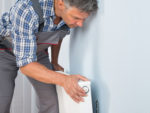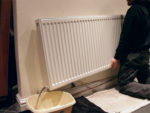This section is all about fitting the part of you central heating system that emits or transfers the heat into the rooms of your home. We cover all aspects of radiators, under floor heating and heated rails, so that you can be confident in installing, maintaining and finding faults with them.
Here we will cover the different types of radiator, rails and under floor heating so that you understand the options and which is best suited to your home and budget.
We have a separate section with will cover Heating and Zoning Controls [LINK to follow] which includes a project dedicated to the TRV or Thermostatic Radiator Valve which are commonly found on many radiators.
There is a section dedicated to all aspects of Heating Central Heating and Boilers which covers many other features of the whole system beyond just the part that transfers the heat into your room.
If you have specific questions about particular branded equipment or obscure product, such as a specific make of boiler of radiator, we have an active Heating Forum where you can post questions or share your experiences. This is a great resource where a lot of time-served tradesmen will be happy to help you.
Different Types of Radiator
There are a number of different types of radiator, and a radiator can be any shape or size which means that there are some amazing designs out there.

When it comes to more standard radiators that most people opt for there are a number of different options:
Panel Radiators
A single panel radiator is a single panel and they are thin and compact, however they only allow mainly radiant heat, and despite their name radiators are much more efficient at transferring heat by convection. They can be Double Panel which increases the amount of heat that they can transfer (but not by double).


It is rare to find a panel radiator now, as they are so much more less efficient than convection radiators.
Convection Radiators
These radiators have fins at the back and between the panels, which increase the surface area and encourage air to rise behind or between the panels so as to spread the heat using convection. They take more space but are much more efficient.



By adding the panels and convectors you will increase the output of the radiator. The convector particularly increases the surface area and capacity to generate convection so making the radiator more efficient.
The extra panel and convector will take up more space. Of course there are some people who will appreciate this:

Traditional Radiators
These are the large cast iron radiators that were the common design in the Victorian period. They are very dramatic and can look fantastic in the right sort of property, however they are now where near as efficient at transferring heat into the room as a modern design.

If you opt for one of these remember that they will be very heavy, even before they are full of water, so make sure the floor can support them. While it might seem a good idea to get a reconditioned one from a reclamation yard, this might lead to problems, over and above sand blasting a century’s worth of paint off. They might have cracks which will leak, or the gaskets sealing the joints between sections might have gone. These are all solvable problems, but it is much easier to get a replica (only you need know!).
When selecting the radiators for your home, ensure that you get the right output for the room that needs to be heated. We have a handy calculator to help you work out the size of radiator(s) that you need for each room.
Types of Under Floor Heating
There are essentially two types of under floor heating:
- Water or Wet
- Electric or Dry
The water type of under floor heating uses pipe work under the floor to turn the whole floor into a great big radiator. Electric type uses electric wires also laid in the screed to do the same. The temperature is lower than a traditional radiator, but it doesn’t need to be high because the surface area of the floor is so much greater.

Electric under floor heating can be laid in a mat under the floor covering.
Pros and Cons of the Different Types of Under Floor Heating
It is much easier to lay electric under floor heating, particularly now that the cables come in mats that can be thrown down on top of the screed. With Water you need to lay the pipes and there needs to be a special manifold to control the water to each separate section (or zone).
Electric is cheaper to install, but more expensive to run. Water under floor heating can be comparable in cost if it is being installed when building from scratch and the floor is already being worked on.















